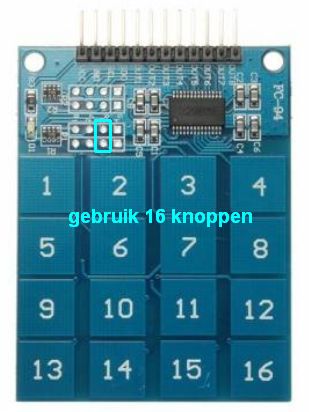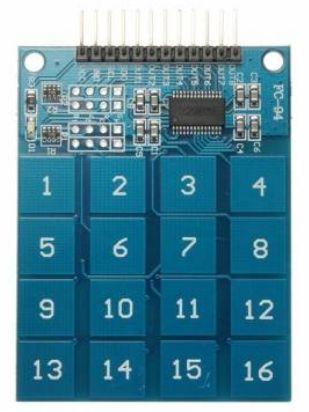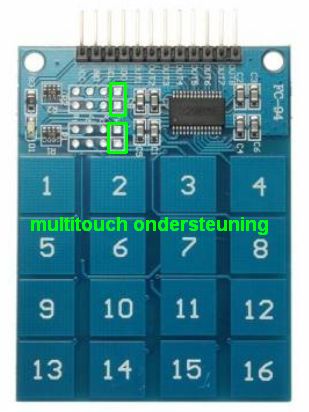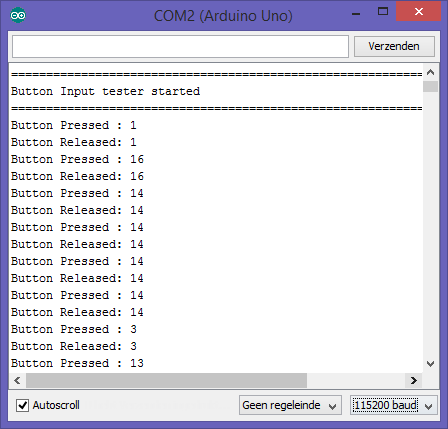Arduino – Keypad 4×4 aanraakgevoelig (TTP229)
Hardware
Veel informatie over deze 4×4 touch keypad is nog niet te vinden, echter hebben sommige mensen hem al aan de praat, er zijn een paar opmerkingen over deze keypad:
1) Standaard gebruikt deze pad 8 knoppen, met het doorverbinden van connecties op punt 3 kan de arduino tot 16 knoppen uitlezen:

2) Standaard kan deze pad 1 knop per keer uitlezen, voor multi-touch moet je connecties op punt 4 en 5 doorverbinden.
Pinout
| Pin: | Functie: |
|---|---|
| 1 | VCC (+3.3v) |
| 2 | GND (-) |
| 3 | SCL (serial clock line) |
| 4 | SDO (serial data line) |
| 5 | Out 1 |
| 6 | Out 2 |
| 7 | Out 3 |
| 8 | Out 4 |
| 9 | Out 5 |
| 10 | Out 6 |
| 11 | Out 7 |
| 12 | Out 8 |
Informatie?
Het uitlezen van de TTP229 keypad module gaat het beste via de data SCL en SDO pinnen.
Aansluiten op de Arduino
Sluit de TTP229 keypad module aan volgens onderstaand overzicht:
| TTP229 pin: | Arduino pin: |
|---|---|
| 1 - VCC (+3.3v) | VCC (+3.3v) |
| 2 - GND (-) | GND (-) |
| 3 - SCL (serial clock line) | D7 |
| 4 - SDO (serial data line) | D2 |
Script
Ik heb hier een script gevonden dat redelijk werkt:
|
1 2 3 4 5 6 7 8 9 10 11 12 13 14 15 16 17 18 19 20 21 22 23 24 25 26 27 28 29 30 31 32 33 34 35 36 37 38 39 40 41 42 43 44 45 46 47 48 49 50 51 52 53 54 55 56 57 58 59 60 61 62 63 64 65 66 67 68 69 70 71 72 73 74 75 76 77 78 79 80 81 82 83 84 85 86 87 88 89 90 91 92 93 94 95 96 97 98 99 100 101 102 103 104 105 106 107 108 109 110 111 112 113 114 115 116 117 118 119 120 121 122 123 124 125 126 127 128 129 130 131 132 133 134 135 136 137 138 139 140 141 142 143 144 145 146 147 148 149 150 151 152 153 154 155 156 157 158 159 160 161 162 163 164 165 166 167 168 169 170 171 172 173 174 175 176 177 178 179 180 181 182 183 184 185 186 187 188 189 190 191 192 193 194 195 196 197 198 199 200 201 202 203 204 205 206 207 208 209 210 211 212 213 214 215 216 217 218 219 220 221 222 223 224 225 226 227 228 229 230 231 232 233 234 235 236 237 238 239 240 241 242 243 244 245 246 247 248 249 250 251 252 253 254 255 256 257 258 259 260 261 262 263 264 265 266 267 268 269 270 271 272 273 274 275 276 277 278 279 280 281 282 283 284 285 286 287 288 289 290 291 292 293 294 295 296 297 298 299 300 301 302 303 304 305 306 307 308 309 310 311 312 313 314 315 316 317 318 319 320 321 322 323 324 325 326 327 328 329 330 331 332 333 334 335 336 337 338 339 340 341 342 343 344 345 346 347 348 349 350 351 352 353 354 355 356 357 358 359 360 361 362 363 364 365 366 367 368 369 370 371 372 373 374 375 376 377 378 379 380 381 382 383 384 385 386 387 388 389 390 391 392 393 394 395 396 397 398 399 400 401 402 403 404 405 406 407 408 409 410 411 412 413 414 415 416 417 418 419 420 421 422 423 424 425 426 427 428 429 430 431 432 433 434 435 436 437 438 439 440 441 442 443 444 445 446 447 448 449 450 |
#include <SPI.h> #if 0 #define DEBUG_BUTTON16(a) (a) #else #define DEBUG_BUTTON16(a) #endif #if 1 #define DEBUG_STATUS(a) (a) #else #define DEBUG_STATUS(a) #endif #pragma pack(push, 0) // TBD: Replace with proper interrupt pin macros. It does not seem to be defined for atmega328p or I am incapable of finding it #ifndef INT0_PIN #ifdef __AVR_ATmega328P__ #define INT0_PIN 2 #else #warning Define INT0_PIN for this microcontroller to use interrupt #endif #endif #ifndef INT1_PIN #ifdef __AVR_ATmega328P__ #define INT1_PIN 3 #else #warning Define INT1_PIN for this microcontroller to use interrupt #endif #endif uint32_t g_intCount = 0; struct CTtp229ButtonEvent { uint8_t ButtonNumber : 5; // ButtonNumber != 0 : Event is present. if equals 0, no event is received uint8_t IsButtonReleased : 1; // True = Button is pressed. False = Button is released }; class CTtP229TouchButton { struct CTtp229Prop { uint16_t SclPin : 6; uint16_t SdoPin : 6; uint16_t Is16Button : 1; #if defined(INT0_PIN) || defined(INT1_PIN) uint16_t HasPendingInterrupt : 1; uint16_t IgnoreNextEvent : 1; // When reading 16th key and if it is pressed, SDO stays low for 2ms. // If we enable interrupt before that, then it will trigger after 2ms, only to find the same condition. // To make things worse, at the end of reading the pin will stay low and generate another interrupt. // TBD: One possible fix is to send more pulses to make it roll over to HIGH. Have to find out if all 16 keys can be pressed in multi-key scenario (NOT supported yet). uint16_t UnhandledButtonPresses; #endif uint16_t PreviousButtonValue; }; static CTtp229Prop g_prop; // // Internal function that captures the data from TTP229 on which key is pressed. // Currently, this function only supports one key being pressed. Multi-key press needs to be added later. // // Return Value : Bit field of buttons pressed // static uint16_t GetPressedButton() { DEBUG_BUTTON16(Serial.println("GetPressedButton : Enter ")); uint16_t buttonsPressed = 0; // Need to generate the LOW and then HIGH on the clock and read the value from data when clock is back high. // As per the specification, the TTP229 chip can support 512Khz. This translates to approximately 2us for a cycle. So introducing clock with fall and raise each of 1us. uint8_t maxCnt = g_prop.Is16Button ? 16 : 8; for(uint8_t ndx = 0; ndx < maxCnt; ndx++ ) { digitalWrite(g_prop.SclPin, LOW); delayMicroseconds(1); digitalWrite(g_prop.SclPin, HIGH); int val = digitalRead(g_prop.SdoPin); delayMicroseconds(1); // Technically this can be moved after the if for most atmel microcontrollers. But if there is a really fast one (now/future) and the next call to GetPressedButton made immediately, we might overclock TTP229. Being safe here if( LOW == val ) { buttonsPressed |= (1 << ndx); } } DEBUG_BUTTON16(Serial.print("GetPressedButton : Exit. Return Value : ")); DEBUG_BUTTON16(Serial.println(buttonsPressed)); return buttonsPressed; } #if defined(INT0_PIN) || defined(INT1_PIN) // Detaching the interrupt after receiving the data can cause problem in sleeping. If the interrupt is not properly dispatched, it can lead to permanent sleep and can't wake up from button static void HandleButtonEvent() { if( g_prop.IgnoreNextEvent ) { // We ignored an event. Now we will accept the event g_prop.IgnoreNextEvent = false; } else { g_prop.HasPendingInterrupt = true; g_intCount++; } } static void SetInterruptHandler() { #ifdef INT0_PIN if( INT0_PIN == g_prop.SdoPin ) { DEBUG_BUTTON16(Serial.println("Configure : With interrupt 0")); EIFR = 0x01; // Clear INTF0 flag attachInterrupt(0, HandleButtonEvent, RISING); // The pin goes down for 93us and then raises that is when the device is ready (technically after 10us) } #endif #ifdef INT1_PIN if( INT1_PIN == g_prop.SdoPin ) { DEBUG_BUTTON16(Serial.println("Configure : With interrupt 1")); EIFR = 0x02; // Clear INTF1 flag attachInterrupt(1, HandleButtonEvent, RISING); // The pin goes down for 93us and then raises that is when the device is ready (technically after 10us) } #endif } static void RemoveInterruptHandler() { #ifdef INT0_PIN if( INT0_PIN == g_prop.SdoPin ) { detachInterrupt(0); } #endif #ifdef INT1_PIN if( INT1_PIN == g_prop.SdoPin ) { detachInterrupt(1); } #endif } #endif // // Returns button number being pressed. High bit indicates more changes present // static uint8_t GetButtonNumberFromFlag(uint16_t buttonsChanged) { uint16_t flag = 1; for(uint8_t ndx = 1; ndx <=16; ndx++, flag <<= 1) { if( (buttonsChanged & flag) != 0 ) { if( (buttonsChanged & ~flag) != 0 ) { // Some other bit is present ndx |= 0x80; } return ndx; } } return 0; } public: // // Setup the TTP229 Touch button on this input. // // Inputs: // sclPin - Clock Pin of the button (3rd from left on button, connected to arduino's digital pin number) // sdoPin - Data pin to read from the button (4th pin from left on button, connected to arduino's digital pin number) // is16Button - true = 16 buttons board. false = 8 button board // static void Configure(int sclPin, int sdoPin, bool is16Button = true) { DEBUG_BUTTON16(Serial.println("Configure : Enter")); g_prop.SclPin = sclPin; g_prop.SdoPin = sdoPin; g_prop.Is16Button = is16Button; g_prop.PreviousButtonValue = 0; // Configure clock as output and hold it high pinMode( sclPin, OUTPUT ); digitalWrite(sclPin, HIGH); // Configure data pin as input pinMode( sdoPin, INPUT); DEBUG_BUTTON16(Serial.print("Button Configuration\n\rSCL Pin : ")); DEBUG_BUTTON16(Serial.println(sclPin)); DEBUG_BUTTON16(Serial.print("SDO Pin : ")); DEBUG_BUTTON16(Serial.println(sdoPin)); DEBUG_BUTTON16(Serial.print("Number of Keys : ")); DEBUG_BUTTON16(Serial.println(is16Button ? 16 : 8)); #if defined(INT0_PIN) || defined(INT1_PIN) g_prop.UnhandledButtonPresses = 0; g_prop.HasPendingInterrupt = false; g_prop.IgnoreNextEvent = false; SetInterruptHandler(); #endif DEBUG_BUTTON16(Serial.println("Configure : Exit")); } // // Get the current status from the 16 button touch device // // Return Value : Returns the bitflag of the keys pressed. returns 0, if no key is pressed. // static uint16_t GetButtonStatus() { #if defined(INT0_PIN) || defined(INT1_PIN) g_prop.HasPendingInterrupt = 0; #endif uint16_t returnValue = GetPressedButton(); #if defined(INT0_PIN) || defined(INT1_PIN) returnValue |= g_prop.UnhandledButtonPresses; // and also include any data that was received that we have not sent yet. g_prop.UnhandledButtonPresses = 0; #endif g_prop.PreviousButtonValue = returnValue; return returnValue; } // // Gets the event from the button. This is useful for monitoring press and release only. // Each button press will generate max 2 events, one for press and another for release. When the button is press and held, this method will return no event. // If the calls were not made often enough, the events could be missed. For instance, you might get 2 pressed, followed by 4 pressed, which automatically means 2 released in single key mode. // // Return Value : if ButtonNumber is 0, then no event // static CTtp229ButtonEvent GetButtonEvent() { CTtp229ButtonEvent returnValue = {0, 0}; uint8_t buttonNumber; DEBUG_BUTTON16(Serial.print("Old Value : ")); DEBUG_BUTTON16(Serial.println(g_prop.PreviousButtonValue)); #if defined(INT0_PIN) || defined(INT1_PIN) if( #if defined(INT0_PIN) INT0_PIN == g_prop.SdoPin #endif #if defined(INT0_PIN) && defined(INT1_PIN) || #endif #if defined(INT1_PIN) INT1_PIN == g_prop.SdoPin #endif ) { // Interrupts are used. Check if we have interrupt if( g_prop.HasPendingInterrupt ) { RemoveInterruptHandler(); // From this point upto SetInterruptHandler is called, ensure there is no return path that will leave without SetInterruptHandler } else { DEBUG_BUTTON16(Serial.println("GetButtonEvent: No interrupt pending")); return returnValue; } } #endif uint16_t currValue = GetPressedButton(); #if defined(INT0_PIN) || defined(INT1_PIN) currValue |= g_prop.UnhandledButtonPresses; // Get any previously returned but not returned now values also into the mix #endif uint16_t changes = g_prop.PreviousButtonValue ^ currValue; uint16_t pressed = (changes & currValue); uint16_t released = (changes & g_prop.PreviousButtonValue); // First check if any key is that is pressed and generate press event if( 0 != pressed ) { buttonNumber = GetButtonNumberFromFlag(pressed); returnValue.ButtonNumber = (buttonNumber & 0x7F); uint16_t mask = (1 << (returnValue.ButtonNumber -1)); // set the new notified button into prev g_prop.PreviousButtonValue |= mask; #if defined(INT0_PIN) || defined(INT1_PIN) g_prop.UnhandledButtonPresses = currValue; g_prop.UnhandledButtonPresses = currValue & ~g_prop.PreviousButtonValue; // clear unhandled for this bit, just in case #endif } else if(0 != released) { buttonNumber = GetButtonNumberFromFlag(released); returnValue.ButtonNumber = (buttonNumber & 0x7F); // The unmatching bit whose previous value of 1 means, it is released returnValue.IsButtonReleased = true; // clear the notified release button g_prop.PreviousButtonValue &= ~(1 << (returnValue.ButtonNumber -1)); } #if defined(INT0_PIN) || defined(INT1_PIN) if(((!returnValue.IsButtonReleased || (0 == pressed)) // We handle release but no pending press && ((buttonNumber & 0x80) == 0 )) // or more button changes are detected || (returnValue.ButtonNumber == 0) ) // safety in case interrupt and data mismatch or code bug { // No more button notification pending g_prop.HasPendingInterrupt = false; } else { DEBUG_BUTTON16(Serial.println("not Clearing interrupt")); } g_prop.IgnoreNextEvent = digitalRead(g_prop.SdoPin) == LOW; // If the pin is still low at the end of reading, ignore next event which is for data finished raise DEBUG_BUTTON16(Serial.print(g_prop.IgnoreNextEvent ? "Ignoring next event\n\r" : "Not ignoring\n\r")); // All the data has been read. Now reactivate the interrupt SetInterruptHandler(); #endif DEBUG_BUTTON16(Serial.print("currValue : ")); DEBUG_BUTTON16(Serial.println(currValue)); DEBUG_BUTTON16(Serial.print("Changes : ")); DEBUG_BUTTON16(Serial.println(changes)); DEBUG_BUTTON16(Serial.print("Button N : ")); DEBUG_BUTTON16(Serial.println(buttonNumber)); DEBUG_BUTTON16(Serial.print("Unhandled : ")); DEBUG_BUTTON16(Serial.println(g_prop.UnhandledButtonPresses)); DEBUG_BUTTON16(Serial.print("ButtonRelease : ")); DEBUG_BUTTON16(Serial.println(returnValue.IsButtonReleased)); DEBUG_BUTTON16(Serial.print("buttonNumber : ")); DEBUG_BUTTON16(Serial.println(buttonNumber)); DEBUG_BUTTON16(Serial.print("Pending interrupts :")); DEBUG_BUTTON16(Serial.println(g_prop.HasPendingInterrupt)); return returnValue; } #if defined(INT0_PIN) || defined(INT1_PIN) static bool HasEvent() { #if defined(INT0_PIN) if( INT0_PIN == g_prop.SdoPin ) { return g_prop.HasPendingInterrupt; } #endif #if defined(INT1_PIN) if( INT1_PIN == g_prop.SdoPin ) { return g_prop.HasPendingInterrupt; } #endif return true; } #endif }; CTtP229TouchButton::CTtp229Prop CTtP229TouchButton::g_prop; CTtP229TouchButton g_ttp229Button; #define TTP16Button g_ttp229Button #pragma pack(pop) void setup() { Serial.begin(115200); DEBUG_STATUS(Serial.println("====================================================================")); DEBUG_STATUS(Serial.println("Button Input tester started")); DEBUG_STATUS(Serial.println("====================================================================")); TTP16Button.Configure(7, 2); } void TestStatus() { uint8_t buttonNumber = TTP16Button.GetButtonStatus(); if( 0 != buttonNumber ) { DEBUG_STATUS(Serial.print("Button Pressed : ")); DEBUG_STATUS(Serial.println(buttonNumber)); } delayMicroseconds(2500); // TTP229 document says it will reset the output if 2ms idle + little bit safety } void TestEvent() { #if defined(INT0_PIN) || defined(INT1_PIN) if( TTP16Button.HasEvent()) #endif { CTtp229ButtonEvent buttonEvent = TTP16Button.GetButtonEvent(); if( 0 != buttonEvent.ButtonNumber ) { if( buttonEvent.IsButtonReleased ) { DEBUG_STATUS(Serial.print("Button Released: ")); } else { DEBUG_STATUS(Serial.print("Button Pressed : ")); } DEBUG_STATUS(Serial.println(buttonEvent.ButtonNumber)); } else { #if defined(INT0_PIN) || defined(INT1_PIN) DEBUG_STATUS(Serial.println("Are you not using interrupt? Should never come here for interrupt based system.")); #endif } //Serial.print("CurrentTime : "); Serial.println(millis()); delayMicroseconds(2500); // TTP229 document says it will reset the output if 2ms idle + little bit safety. Not required if using interrupts } } void loop() { //TestStatus(); TestEvent(); } |
De console output na het aanraken van de vlakken:
[#/datasheets/ttp229″ ]




